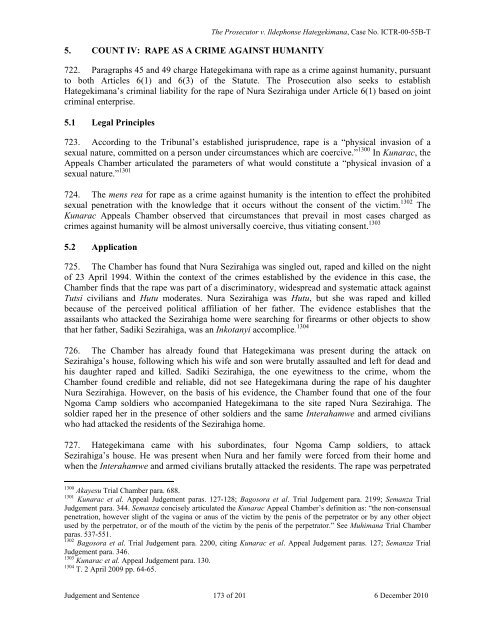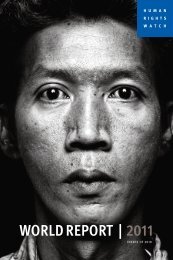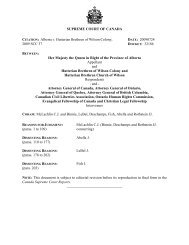Hategekimana - JUDGEMENT & SENTENCE - Refworld
Hategekimana - JUDGEMENT & SENTENCE - Refworld
Hategekimana - JUDGEMENT & SENTENCE - Refworld
Create successful ePaper yourself
Turn your PDF publications into a flip-book with our unique Google optimized e-Paper software.
The Prosecutor v. Ildephonse <strong>Hategekimana</strong>, Case No. ICTR-00-55B-T<br />
5. COUNT IV: RAPE AS A CRIME AGAINST HUMANITY<br />
722. Paragraphs 45 and 49 charge <strong>Hategekimana</strong> with rape as a crime against humanity, pursuant<br />
to both Articles 6(1) and 6(3) of the Statute. The Prosecution also seeks to establish<br />
<strong>Hategekimana</strong>’s criminal liability for the rape of Nura Sezirahiga under Article 6(1) based on joint<br />
criminal enterprise.<br />
5.1 Legal Principles<br />
723. According to the Tribunal’s established jurisprudence, rape is a “physical invasion of a<br />
sexual nature, committed on a person under circumstances which are coercive.” 1300 In Kunarac, the<br />
Appeals Chamber articulated the parameters of what would constitute a “physical invasion of a<br />
sexual nature.” 1301<br />
724. The mens rea for rape as a crime against humanity is the intention to effect the prohibited<br />
sexual penetration with the knowledge that it occurs without the consent of the victim. 1302 The<br />
Kunarac Appeals Chamber observed that circumstances that prevail in most cases charged as<br />
crimes against humanity will be almost universally coercive, thus vitiating consent. 1303<br />
5.2 Application<br />
725. The Chamber has found that Nura Sezirahiga was singled out, raped and killed on the night<br />
of 23 April 1994. Within the context of the crimes established by the evidence in this case, the<br />
Chamber finds that the rape was part of a discriminatory, widespread and systematic attack against<br />
Tutsi civilians and Hutu moderates. Nura Sezirahiga was Hutu, but she was raped and killed<br />
because of the perceived political affiliation of her father. The evidence establishes that the<br />
assailants who attacked the Sezirahiga home were searching for firearms or other objects to show<br />
that her father, Sadiki Sezirahiga, was an Inkotanyi accomplice. 1304<br />
726. The Chamber has already found that <strong>Hategekimana</strong> was present during the attack on<br />
Sezirahiga’s house, following which his wife and son were brutally assaulted and left for dead and<br />
his daughter raped and killed. Sadiki Sezirahiga, the one eyewitness to the crime, whom the<br />
Chamber found credible and reliable, did not see <strong>Hategekimana</strong> during the rape of his daughter<br />
Nura Sezirahiga. However, on the basis of his evidence, the Chamber found that one of the four<br />
Ngoma Camp soldiers who accompanied <strong>Hategekimana</strong> to the site raped Nura Sezirahiga. The<br />
soldier raped her in the presence of other soldiers and the same Interahamwe and armed civilians<br />
who had attacked the residents of the Sezirahiga home.<br />
727. <strong>Hategekimana</strong> came with his subordinates, four Ngoma Camp soldiers, to attack<br />
Sezirahiga’s house. He was present when Nura and her family were forced from their home and<br />
when the Interahamwe and armed civilians brutally attacked the residents. The rape was perpetrated<br />
1300 Akayesu Trial Chamber para. 688.<br />
1301 Kunarac et al. Appeal Judgement paras. 127-128; Bagosora et al. Trial Judgement para. 2199; Semanza Trial<br />
Judgement para. 344. Semanza concisely articulated the Kunarac Appeal Chamber’s definition as: “the non-consensual<br />
penetration, however slight of the vagina or anus of the victim by the penis of the perpetrator or by any other object<br />
used by the perpetrator, or of the mouth of the victim by the penis of the perpetrator.” See Muhimana Trial Chamber<br />
paras. 537-551.<br />
1302 Bagosora et al. Trial Judgement para. 2200, citing Kunarac et al. Appeal Judgement paras. 127; Semanza Trial<br />
Judgement para. 346.<br />
1303 Kunarac et al. Appeal Judgement para. 130.<br />
1304 T. 2 April 2009 pp. 64-65.<br />
Judgement and Sentence 173 of 201 6 December 2010

















